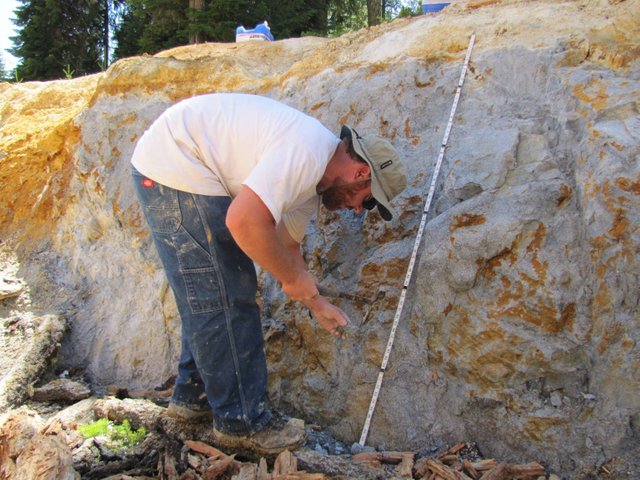The Natural Occurrence of Clayey Raw Minerals

"The Natural Occurrence of Clayey Raw Minerals"
Clay is the common term used to describe minerals which exhibit plasticity when it is added with specific amount of water. Generally, any dirt or mud which adhesively sticks with our shoes during rainy days are types clays. Clay is the most important constituent of soil due to its unbalanced negative charges. It can also appear in various colors based on the soil’s components and contents. Technically, clays are hydrous aluminum phyllosilicates with various contaminants or impurities such as iron, magnesium, calcium, potassium and any other volatile or organic materials.
Phyllosilicate comes from the Greek word φύλλον or phyllon or leaf, and by that it means that clay mineral structures are arranged into parallel sheets of silicates. Basically, there are two classification of clay minerals based on their structure; 1:1 or 2:1 clay.
The 1:1 clay would consist of one tetrahedral sheet and one octahedral sheet, and examples would be kaolinite and serpentine. On the other hand, 2:1 clay consists of an octahedral sheet sandwiched between two tetrahedral sheets, and examples are talc, vermiculite and montmorillonite.
Anyway, the minerals which are generally found on clay are silicates with the size of less than 2 microns. However, the amount of components on clay minerals depends primarily on the deposit sites of where the clay minerals are excavated. Moreover, the small particle size of these components gives clay minerals their individual, unique and varying physical and chemical properties such as plasticity and swelling behavior. Also, properties before and during firing may differ significantly based on the types of clay.
Clay minerals are abundant and can be found almost everywhere in earth’s surface. These clay minerals are normally formed due to continuous and gradual chemical weathering of rocks over a long period of time. This process involves initial transformation of original rock to form new minerals which in this case are the clay minerals. Thus the initial rock experienced slight physical and chemical alteration through time until physical disaggregation and chemical decompositions are observed.

Subsequent deposition of these clay minerals follows. There are mainly two types of clay deposits, primary and secondary deposit. Primary clay deposits or residual clay deposits are clay deposits in which clay minerals are found directly in the initial or the place of origin where they are formed. Secondary clay deposits are deposits of clay minerals which are transported from their original place where they are formed through wind, water erosion and other naturally occurring phenomena. These clay deposits are typically situated near water basins such as large lakes and river or to low energy depositional environments.
Clay minerals are major components of almost all sedimentary rocks and they also form rocks which are known as shales. These shales are sedimentary rocks which are primarily composed of muds and other minerals such as silica and calcite. These rocks can be classified and identified based on their grain size and properties. Disintegration of shales may also result in formation of residual clay minerals.

Clay minerals are grouped accordingly; these groups are kaolinite group, smectite or montmorillionite group, illite group and chlorite group. Each group has their own particular and individual properties, varying structures and appropriate use for industrial application. There are also mixed layer of clay minerals based on these groups which are indicated with random or regular ordering which is further describe by the German term reichweite which means range or reach. I will not go further with more technical terms.
This is one reason why resulting ceramic products may vary significantly after in a long run eve given the same procedural parameters. It is then advisable to conduct preliminary and thorough experimentation of the raw materials to be used prior to utilization. Mineralogy and mineral components analysis may slightly vary sometimes but such case can be resolved by modifying parameters of manufacturing process such as firing temperature to come up with nearly identical or similar product.
The use of clay minerals has existed long ago for different purposes either aesthetic or for industrial use. However, ceramics is a broad field of study. Though these raw materials are abundant in nature, the energy or the fuels used in manufacturing these products are still expensive. Therefore, one should need to study its nature. But one does not simply become an expert of ceramics due to the numerous raw materials which exist today. Each raw material then has various subdivisions and classifications. I hope that you learned from my articles.
THANK YOU FOR TAKING THE TIME TO READ MY ARTICLE
Diamonds Are Not Forever if We Understand its Nature and its Crystal Structure
Ceramics Water Filter for Safer and Healthier Drinking Water
Types of Portland Cement and its Individual Use in Construction
An Overview on the Manufacturing Process of Cement Industry
References:
Introduction to the Properties of Clay Minerals by Stephen Guggenheim
Clay Minerals by CD. Barton, A.D. Karathanasis
https://en.wikipedia.org/wiki/Clay_minerals
https://en.wikipedia.org/wiki/Clay
https://pubs.usgs.gov/info/clays/
https://www.ucl.ac.uk/earth-sciences/impact/geology/london/ucl/materials/clay



This post was resteemed by @steemitrobot!
Good Luck!
The @steemitrobot users are a small but growing community.
Check out the other resteemed posts in steemitrobot's feed.
Some of them are truly great. Please upvote this comment for helping me grow.
Thanks for the valuable info. Gained a knowledge
Thanks, glad I helped.
Galing mo talga Up. Good to learn more about clay. :)
@asbonclz Excellent, follow up . Thank you very much